Abstract
Intelligent textile clothing is one of the most popular topics in the field. In recent decades, rapid advances have been made in the area of intelligent textile clothing research, and the intellectual structure pertaining to this domain has significantly evolved. We used CiteSpace 6.2.R4, VOSviewer 1.6.19, to evaluate and visualize the results, analyzing articles, countries, regions, institutions, authors, journals, citations, and keywords. Both a macroscopic sketch and a microscopic characterization of the entire knowledge domain were realized. The aim of this paper is to utilize bibliometric and knowledge mapping theories to identify relevant research papers on the subject of smart textiles and clothing that have been published by the China Knowledge Network Web of Science (WOS) within the last decade. It is concluded that the main topics of smart textile and garment research can be divided into nine categories: wearable electronics, smart textiles, flexible antennas, energy storage, textile actuators, mechanical properties, asymmetric supercapacitors, carbon nanotubes, and fiber extrusion. In addition to the latter analysis, emerging trends and future research foci were predicted. This review will help scientists discern the dynamic evolution of intelligent textile clothing research as well as highlight areas for future research.
1. Introduction
With the increasing popularity and advancement of smart textile clothing, a wide range of smart clothing products are gaining traction in the market. As a result, people have developed multifaceted demands for smart textile clothing with respect to its functionalities [1]. Due to the interesting electrical, thermal, and optical properties of smart textile garments, among others, a high degree of innovation and smart garment potential can be realized, e.g., they can be used simultaneously as sensors, heaters, energy generators, and storage devices. Smart textiles and clothing products utilize feedback mechanisms to sense changes in both the external environment and the human body, allowing for a triangular interaction between the wearer, their surroundings, and their garments. This creates an interdependent organism. The development of intelligent textile garments requires multidisciplinary technical support and the integration of advanced technologies from various fields, including biotechnology, sensor technology, computer science, microelectronics, polymer chemistry, and materials science and technology [2,3,4].
There have been numerous studies and reports on wearable technology [5,6,7], garment design [8,9,10], and smart clothing [11,12,13] in the context of smart textile garments. The aim of this paper is to utilize bibliometric and knowledge mapping theories to identify relevant research papers on the subject of smart textiles and clothing that have been published by the China Knowledge Network Web of Science (WOS) within the last decade. We used CiteSpace 6.2.R4 and VOSviewer 1.6.19 software to analyze the data, aiming to understand the research hotspots and trends in the field of smart textiles and clothing in China in recent years. Additionally, we provided references for future research on this topic.
2. Research Methodology and Data Analysis
2.1. Research Methodology
The CiteSpace 6.2.R4 and VOSviewer 1.6.19 software were used to analyze the knowledge structure, developmental patterns, and distribution of intelligent textiles and garments. A knowledge graph is presented to illustrate the relationship between the annual article volume, organizational affiliations, and author collaborations in this research field. This graph intuitively reflects the internal relationships and trajectories within this field of study while also sorting out its research trajectory and future trends [14].
2.2. Data Analysis
The data sources utilized in this study comprise the Web of Science (WOS) core collection database, which was searched from 1 January 2012 to 31 December 2022.
A precise search was conducted in the WOS core collection database for articles with subject terms (TS) = “Smart clothing*” or “Smart textiles*”. The retrieval strategy is shown in Figure 1. The literature category included papers, reviews, and online publications in the English language. The retrieved articles were exported in plain text format, including both full records and cited references, resulting in 2456 articles. After deduplication processing, 2398 valid pieces of literature were obtained.

Figure 1.
Flowchart steps of the search strategy.
3. Results and Analysis
3.1. Volume of Literature
The annual article count serves as a visual indicator of the current research status and facilitates the identification of developmental trends, which is crucial for predicting future directions. Based on the data from the WOS, Figure 2 depicts the trend graph of the article counts.
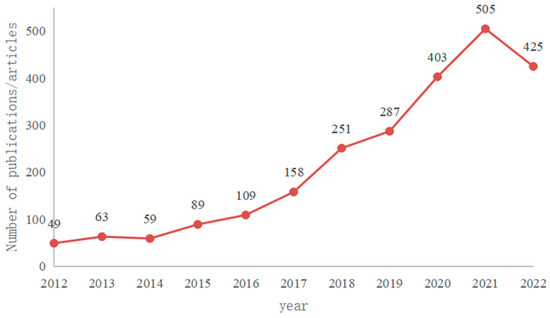
Figure 2.
Statistical chart of documents issued.
Figure 2 showed an upward trend in the overall number of WOS database papers from 2012 to 2022. Specifically, the average annual number of WOS articles is approximately 218, which has been growing rapidly since 2015, exceeding 200 articles for the first time in 2018 and reaching 505 articles in 2021. The growth trend in the WOS’s postings since 2017 is apparent, with an average annual growth of 27.7%.
3.2. Network Analysis of the Country Based on Published Articles
National cooperation network mapping can be used to visualize the degree of connection and social relationships between different countries in this research field, providing a novel perspective for evaluating the academic influence and research capacity of nations. WOS documents were used to construct the cooperation network mapping between countries and regions, as presented in Table 1 and Figure 3.

Table 1.
Top five countries in terms of publication volume and centrality.
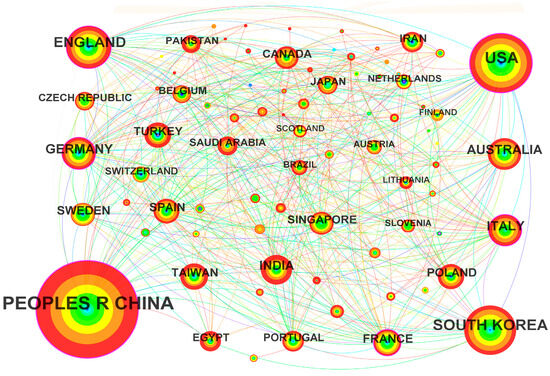
Figure 3.
Map of national and regional cooperation networks.
In the field of smart textiles and apparel, the WOS database contains 2398 papers published in 83 countries and regions. China leads with 909 papers, followed by the United States with 338 papers. Korea ranks third with 246 papers, and England and Australia follow closely behind with 187 and 105 papers, respectively. In Figure 2, China and the United States are the two dominant nodes, indicating their significant research leadership in this field compared to other countries. The United States has the highest cooperation centrality at 0.24, demonstrating its close collaboration with a total of 42 countries and regions. The quantity of literature published in China and indexed in WOS has significantly grown in recent years, with a cooperation centrality of 0.21, ranking second. This indicates the high level of international collaboration among Chinese scholars.
3.3. Institutions Analysis
Analyzing research institutions can facilitate our comprehension of the key players in the field and offer guidance for scholars in selecting collaborative partners. The top 10 institutions, ranked by the number of their published articles in the WOS database [15], are tabulated as shown in Table 2.

Table 2.
Top 10 institutions in terms of publication volume and centrality.
The VOSviewer 1.6.19 software was used to visualize collaborative networks among research institutions in the WOS literature. Among these, 224 foreign research institutions were identified, including Donghua University (141 articles), the Chinese Academy of Sciences (124 articles), Hong Kong Polytechnic University (86 articles), Jiangnan University (74 articles), Qingdao University (67 articles), the University of Boras (53 articles), Soochow University (46 articles), the University of Chinese Academy of Sciences (45 articles), the University of Manchester (40 articles) and Georgia Institute of Technology (31 articles). The number of articles issued by these institutions is substantial. This analysis indicates that Donghua University and the Chinese Academy of Sciences have the highest number of publications in English. Please refer to Table 2 and Figure 4 for details.
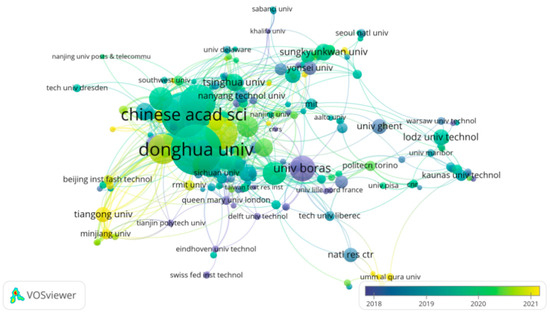
Figure 4.
WOS Collaborative network of research institutions based on the literature.
3.4. Author Group Analysis
To gain a deeper understanding of the fundamental structure of this field, it is crucial to identify its core authors. Table 3 presents the top six author groups ranked by their publication output. The statistical analysis was conducted in accordance with the Price formula , where M represents the number of publications by core authors and represents the number of publications by the author with the highest output in that year. The selection criteria must be greater than or equal to the number of publications by core authors [15,16]. In the WOS database, there were 71 core authors who had published more than five articles. Only one author, Li Yi’s group from the University of Manchester, had published more than 20 articles. Li Yi is considered a prolific author, with a total of 35 publications.

Table 3.
Top six authors in terms of publication volume.
In the WOS database, there are 54 distinct clusters of core authors based on publication volume (see Figure 5), and the number of papers published by a maximum of one author per cluster was selected as the standard. Li Yi’s group (35 articles), Wang Zhong Lin’s group (23 articles), Qu Lijun’s group (20 articles), Chen Jun’s group (18 articles), and Zheng Zijian’s group (15 articles) each form a cluster. Each cluster contains more than two authors. There are nine closely cooperative teams, several of which have long-term collaborations with high publication volumes. This forms a stable cross-team communication and cooperation network. The most prominent team is Li Yi’s group at the University of Manchester, whose collaborative network is the largest in this field. Their research focuses on characterizing wearable tensile strain sensors [17].
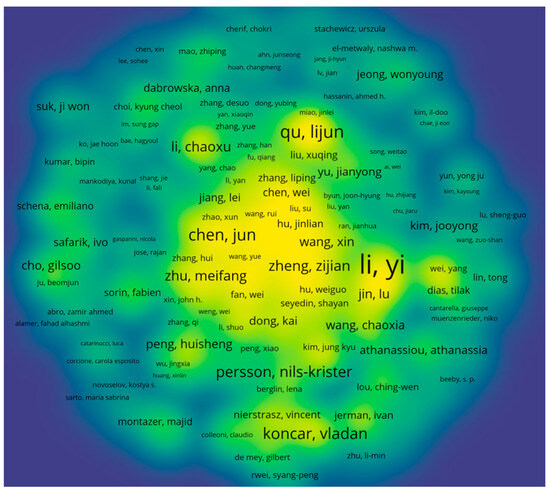
Figure 5.
Density view of literature authors.
3.5. Journals Analysis
Papers related to intelligent textile clothing were published in 296 journals from 2012 to 2022. We listed the top ten journals in this field based on the number of publications, as demonstrated in Table 4. ADV MATER was in first place with 447 published articles, ACS APPL MATER INTER was in second place with 169 articles, and ADV FUNCT MATER was in third place with 124 articles.

Table 4.
Top 10 most productive journals.
The JIF of a journal is another important parameter to evaluate the value of the journal itself and the publications included in it. Among the top 10 academic journals, Science had the highest JIF at 10.15, followed by ADV MATER at 4.18, and both were classified as Q1. Additionally, the top three H-index journals were SCIENCE (1058), ADV MATER (447), and NANO LETT (430). Based on the above, we believe that Science and Ad Mater are the more authoritative journals in this field.
3.6. Citations Analysis
Citation analysis is an important indicator in bibliometric studies [18,19]. A total of 254 co-cited references were visualized using CiteSpace 6.2.R4, with the time slice set as one year and the time span spanning from 2012 to 2022. Table 5 showed the top ten most cited papers, including four review studies (Stoppa M et al., 2014 [20]; Zeng W et al., 2014 [21]; Heo JS et al., 2018 [22]; and Amjadi M, 2016 [23]) and six experimental studies (Dong K et al., 2020 [24]; Weng W et al., 2016 [25]; Shi JD et al., 2020 [26]; Pu X et al., 2016 [27]; Lee J et al., 2015 [28]; Chen J et al., 2016 [29]), which focused on the electronic components and multi-functions of smart textiles. The most-cited papers were written by Stoppa M’s group, who work at the University of Istituto Italiano di Tecnologia (IIT), reflecting their great influence in the field. Citation bursts refer to references that caught the attention of scholars in a specific field at a specific time interval and whose analysis can be used to observe the evolution of a field of knowledge and to predict frontier trends. In Table 6, the timeline is shown in a circle, and the burst time interval is shown in a solid black circle, indicating the start year, end year, and duration of the burst. Of these burst citations, the shortest burst duration for intelligent textiles and garments was one year, and the longest was four years. Notably, 40% of the citation bursts ended close to 2019, focusing on advances in flexible sensitive strain sensors and supercapacitors (Amjadi M et al., 2016 [23]; Wen Z et al., 2016 [30]; Pu X et al., 2016 [27]; Ren JS et al., 2017 [31]; Kou L et al., 2014 [32]). Additionally, 15% of the citation bursts ending in 2022 or later focused on smart textiles that integrate microelectronic systems and functional textiles (Hsu PC et al., 2016 [33]; Zhao ZZ et al., 2016 [34]; Shi JD et al., 2020 [26]), suggesting that these research topics have been receiving attention in recent years and are expected to be a focus of research in the future.

Table 5.
Top 10 most cited references.

Table 6.
Top 25 references with the strongest citation bursts.
3.7. Keywords Analysis
This paper used VOSviewer 1.6.19 to visualize keywords in the literature and employed a keyword co-occurrence analysis to explore research hotspots in smart textiles and apparel. To gain a deeper understanding of this field, we constructed visual maps for 2398 English literature, as shown in Figure 6.
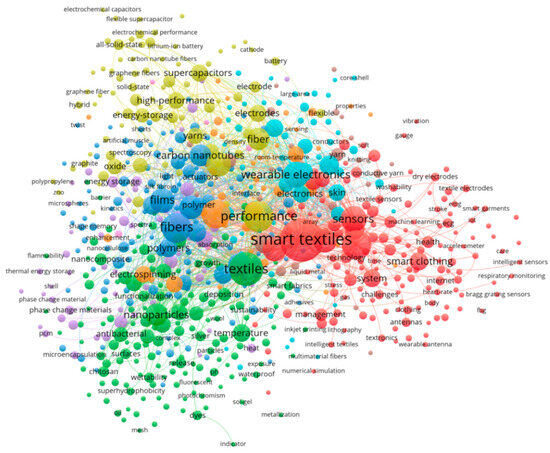
Figure 6.
WOS keyword co-occurrence map.
The keywords were analyzed based on literature indexed in the Web of Science database. The most frequently occurring terms included smart textiles, fibers, performance, sensors, composites, textile design, fabrication techniques, and nanocomposites. After excluding self-referential terms, the frequently occurring keywords included fibers, performance, sensors, composites, design, fabrication, and nanocomposites. Based on these identified keywords, it is evident that research on smart textiles and clothing can be classified into two distinct directions. The first direction pertains to material development, which includes smart fiber materials [49,50] such as composite materials, nanocomposites, phase change fibers, and shape memory fibers. The chemical fibers can be purified and deodorized by adding nano-level ZnO, SiO2, or other chemicals. Adding nanometer-sized ZnO to polyester fiber can increase the material’s anti-ultraviolet and anti-bacterial abilities. Adding nano-sized metal particles to the chemical fibers can enhance the antistatic ability of the material. Adding nanoscale silver ions to the chemical fibers can enhance the material’s own bactericidal ability. In addition, adding carbon black nanoparticles to rubber materials can also greatly improve the strength and anti-wear properties of rubber materials, thereby improving their service life. The second aspect concerns garment design, which involves dividing smart garment design into areas such as garment structure and fabric elasticity to create functional garments that address specific issues [51].
A keyword clustering analysis facilitates the identification of relevant studies in a given field. A visual clustering analysis of these keywords was conducted using the LLR test algorithm within the CiteSpace 6.2.R4 software. We identified the key research areas in intelligent textiles and clothing from 2012 to 2021, and their clustering is illustrated in Figure 7.
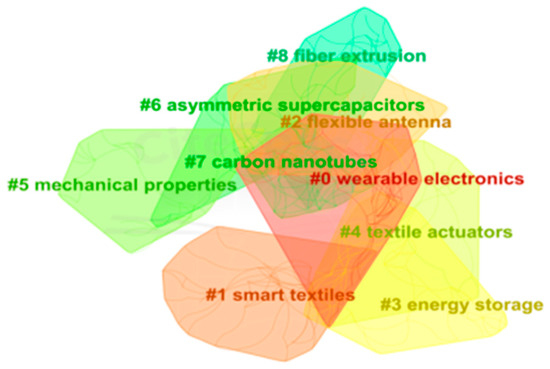
Figure 7.
Keyword clustering map.
The clustering module (Q) for the WOS literature keywords is 0.768, with an average contour value (S) of 0.906, as depicted in Figure 7. The top nine keywords with the highest frequency are “wearable electronics”, “smart textiles”, “flexible antennas”, “energy storage”, “textile actuators”, “mechanical properties”, “asymmetric supercapacitors”, “carbon nanotubes,” and “fiber extrusion”. It can be seen that the English literature also focuses on smart wearable products and smart textiles. English literature places more emphasis on mechanical properties, capacitors, and other electronic devices in smart textiles and garments. This indicates that the interaction design between electronic devices and clothing is a research hotspot.
By importing the data into Gephi 0.9.7 and utilizing Scimago Graphica software for timeline graphical analysis of literature keywords, we can correlate and analyze different clusters over time, illustrating the development and coherence of research content within each cluster. This approach clearly demonstrates trends in intelligent textile and clothing research.
A time zone map provides a view that represents the evolution of knowledge in the time dimension, which can intuitively show the changes and mutual influences of research hotspots [52]. In the time zone diagram of WOS keywords, as depicted in Figure 8, the literature clustering of smart textiles, carbon nanotubes, sensors, and wearable devices continue to be the present throughout the time span and have good time continuity. The pivotal node of smart textiles emerged in 2012. The most frequently cited literature on this topic within the experimental database [53] reveals that researchers have developed a flexible and stretchable electronic circuit technology that integrates electronic systems into elastomeric materials to produce complex functional, stretchable, and flexible electronic modules. The primary focus in 2013 was on biological materials. Since 2015, yarn supercapacitors have become a prominent topic in the field and are expected to remain so until 2022. In summary, research on smart textiles and carbon nanotubes began in 2012. Carbon nanotubes can optimize the cooperative loss mechanism of multiple components and the absorbing performance by combining with magnetic metals and metal compounds. This is an effective ways to achieve thinness, a light weight, a wide frequency band, and strong absorption of the absorbing materials. For example, using cellulose fibers as raw materials can realize the preparation of carbon nanotube absorbing materials. Using carbon nanotubes and metal materials as functional particles, textile absorbing materials can be prepared through electrospinning and finishing [54]. The timeline of smart materials research shows that in 2013, there was a notable focus on this area. Starting in 2014, there has been a focus on wearable electronics and energy storage within the realm of smart textile and clothing research. The research focus in 2015 was mainly on posture pressure, while from 2016 to 2018, the emphasis shifted towards wearable strain sensors and 3D printing, both of which are within the scope of intelligent textile clothing research. From 2019 to 2022, the main directions for intelligent textile clothing research will include shape memory and electronic skin development, as well as wearable strain sensing. The term “emergent keyword” refers to a word that experiences a sudden increase in frequency within a specific time period, with the growth rate of this word intensifying. This intensity can serve as an indicator of research hotspots and trends during the aforementioned period. By utilizing CiteSpace 6.2.R4 software to track emerging keywords in the literature from the WOS, we can gain insights into the evolutionary dynamics of research hotspots in intelligent textiles and clothing, ultimately enabling us to predict future development trends.
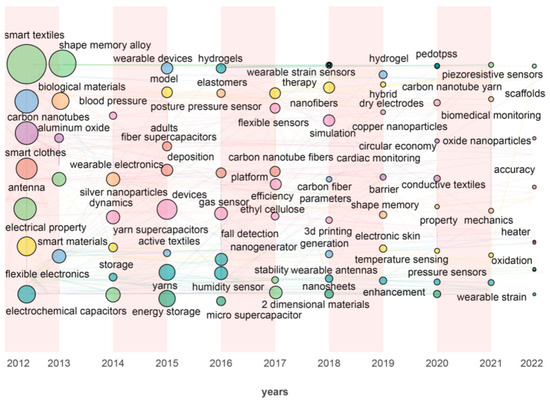
Figure 8.
WOS keyword time zone map.
Figure 9 displays the emerging foreign research terms in the field of smart textiles and clothing from 2012 to 2022. By conducting a keyword emergence analysis of the WOS literature, we identified a total of 15 keywords with the highest emergence intensity. These can be roughly divided into two phases based on time: (1) From 2012 to 2018, fifteen emerging research hotspots were identified, including “circuit”, “smart fabric”, “yarn supercapacitor”, and “flexible supercapacitor”. Among these hotspots, the research on “yarn” has been continuously pursued for three to four years. Currently, foreign scholars are focusing their attention on smart fabrics and electronic components. Smart textile garments use yarn supercapacitors as energy storage devices. Large, high-stretch yarn electrodes are manufactured using CNI impregnation and PPy electrodeposition processes [55]. Flexible supercapacitors have unique advantages in terms of flexibility, shape, and weight due to the development of carbon-based materials, composite materials, and flexible micro-supercapacitors [56,57]. In addition, research on smart fabrics has make a significant contribution to the development of smart clothing. For example, superhydrophobic-coated fabrics have facilitated the creation of smart oil and water separators, microfluidic valves, and chip experimental devices [58]. (2) In the years 2019–2022, foreign scholars primarily focused on the development of pressure sensors in wearable devices and conductive textile research. For instance, thin-film flexible wireless pressure sensors can provide a wireless monitoring platform [59]. Conductive textiles, including graphene-based textiles, offer technical advantages in wearable products such as improved conductivity, ultra-flexibility, and machine washability [60]. The current focus of scholarly research is on wearable devices, which require a multidisciplinary approach to information collection, processing, storage, battery technology, intelligent operating systems, and human–computer interaction design. The integration of data processing, software, and haptic technologies enables the achievement of specific intelligent functions [61,62].
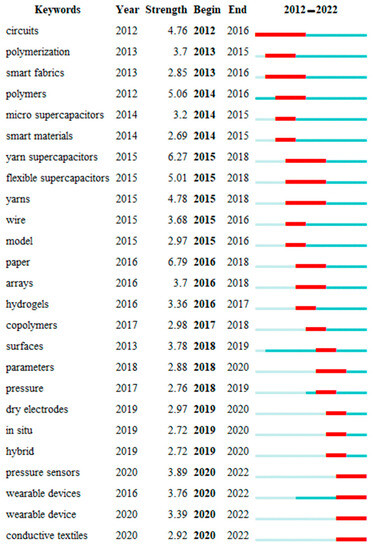
Figure 9.
Prominent words in WOS intelligent textile and apparel research, the timeline is shown in blue, and the interval at the time of the burst is shown in red, indicating the start year, the end year, and the duration of the burst.
4. Limitations
The present study attempted to conduct a comprehensive bibliometric analysis of papers related to intelligent textile clothing from 2012 to 2022. Although this paper presents some meaningful findings, there are some limitations. Due to the formatting requirements of the CiteSpace 6.2.R4 software, all the data were retrieved and downloaded from the Web of Science database, excluding other databases such as CNKI and Wanfang. Additionally, we have restricted the indexing, article type, and language type of the search, which may result in the omission of some high-quality articles. However, we believe that the volume of data retrieved is large enough to adequately reflect the current state of the research.
5. Conclusions
A combination of bibliometric and knowledge mapping analysis methods was used to reveal the multidimensional structure and network relationships of relevant research in the field of smart textiles and garments based on the WOS database. The main conclusions are as follows:
- (1)
- In terms of the number of published papers and countries represented, the WOS has seen a steady increase in publications since 2015, with particularly rapid growth observed after 2017 in terms of the number of published papers and countries represented. The United States has maintained close collaborations with other countries and regions, followed by China, which has also emerged as a leading contributor to global research output in recent years.
- (2)
- From the perspectives of the authors and institutions, the WOS database research institutions are very close, with institutions such as the University of Boras, Sweden, Sungkyunkwan University, Korea, and the University of Manchester, UK, forming the central collaborative forces. Among them, scholars such as Li, Yi, Qu, Lijun, Jin, and Lu form the core group of authors, whose research concentration and intensity of cooperation are greatest.
- (3)
- Based on the journals and citations, SCIENCE and ADV MATER are the authoritative journals in the field in the WOS database, and together with journals such as ACS APPL MATER INTER, NANO LETT, and ADV FUNCT MATER, they constitute the top journals in the field. The most cited paper was written by the Stoppa M. group, which had a significant influence. It can be seen from the citation explosion that research in this field focuses on flexible, sensitive strain sensors, supercapacitors, integrated microelectronic systems, and functional textiles.
- (4)
- Based on the analysis of keyword co-occurrence, the keywords in the WOS database have a high frequency of occurrence and diversified research topics. The overall intensity of keywords for smart textiles and clothing in the WOS database is large, and there is a significant difference in intensity among the emergent words. The literature in the WOS database focuses more on the manufacturing of electronic components and smart fibers and polymers in smart textiles and clothing. Therefore, future research on electronic component manufacturing and smart fibers and fabrics in the field of smart textiles and apparel is expected to be the focus of attention.
- (5)
- From the point of view of research hotspots and stage characteristics, the research hotspots in the WOS in recent years have been more diverse, involving yarn supercapacitors, biomaterials, carbon nanotubes, wearable strains, and electronic skin. Future research is expected to pay more attention to the intelligence of fibers and fabrics and the accurate detectability of electronic components. This work will strengthen the development of intelligent core technology, which will also be a key focus in the future.
Author Contributions
T.W. and C.L. designed the study. J.Z. and A.W. collected the data. C.L., T.W. and A.W. re-examined the data. T.W., C.L. and A.W. analyzed the data. T.W. and C.L. wrote the manuscript. A.W. and J.Z. reviewed and revised the manuscript. All authors have read and agreed to the published version of the manuscript.
Funding
This research was funded by the Shaanxi Provincial Key Research and Development Program 2023 (2023-YBSF-203).
Data Availability Statement
Further inquiries can be directed to the corresponding authors.
Conflicts of Interest
The authors declare no conflict of interest.
References
- Shen, L.; Sang, P.; Xie, Z. Development of intelligent cycling clothing based on outdoor visual warning functions. Knitt. Ind. 2019, 1, 57–61. [Google Scholar]
- Tian, M.; Li, J. The design model and development trend of intelligent clothing. J. Text. 2014, 35, 109–115. [Google Scholar]
- Van Langenhove, L.; Hertleer, C. Smart clothing: A new life. Int. J. Cloth. Sci. Technol. 2004, 16, 63–72. [Google Scholar] [CrossRef]
- Tian, M.; Zhang, G.; Qu, L.; Wang, B.; Shi, Y. The application of conductive fibers and their flexible sensors in the field of wearable intelligent textiles. Basic Sci. J. Text. Univ. 2021, 34, 51–59. [Google Scholar]
- Ahsan, M.; Teay, S.H.; Sayem, A.S.M.; Albarbar, A. Smart Clothing Framework for Health Monitoring Applications. Signals 2022, 3, 113–145. [Google Scholar] [CrossRef]
- Su, Y.G.; Zhao, X. Modern garment design from the perspective of smart textiles. Woolen Technol. 2020, 48, 102–106. [Google Scholar]
- Sun, Y.; Fan, J.; Wang, L.; Liu, Y. Research Progress on the Application of Wearable Technology in Textile and Apparel. J. Text. 2018, 39, 132–138. [Google Scholar]
- Wang, X.; Yu, M.; Zhang, C.; Zheng, G.; Qin, R.; Liu, J. Based on flexible sensor application and progress of smart clothing. Basic Sci. J. Text. Univ./Fangzhi Gaoxiao Jichu Kexue Xuebao 2019, 32, 133–137. [Google Scholar]
- He, S.; Jin, H.; Hong, W.; Liu, Z. Design and application research of knitted flexible intelligent patient garments. Knitt. Ind. 2020, 7, 81–84. [Google Scholar]
- Yan, N.; Zhang, H.; Deng, Y. Research status and development trend of wearable medical monitoring clothing. J. Text. 2015, 36, 163–167. [Google Scholar]
- Xie, H.Y.; Tang, H.; Gu, L.Y.; Sun, J.; Gao, Q.; Zhang, S.B. Research on Intelligent Fire Underwear Based on Temperature and Humidity Monitoring Function. Knitt. Ind. 2019, 5, 58–62. [Google Scholar]
- Wang, Y.; Deng, Y.; Yang, X. Research status and development trend of breast monitoring intelligent underwear. Knitt. Ind. 2018, 5, 62–65. [Google Scholar]
- Tang, Q.; Zhang, B.; Zheng, X. Infant wearable intelligent monitoring clothing design. Acta Textile Sinica 2021, 42, 156–160. [Google Scholar]
- Sheng, Q.; Zheng, J.; Liu, J.; Shi, W.; Li, H. Research progress and trends in CiteSpace-based inner surface defect detection. Spectrosc. Spectr. Anal. 2023, 43, 9–15. [Google Scholar]
- Zhang, X.; Wang, J.; Hu, J.R.; Wang, Y.; Lai, J.; Zhou, L.Y.; Zhu, Y.C. Visual analysis of surimi research based on CiteSpace and the bibliometric analysis platform. Food Sci. 2023, 44, 362–370. [Google Scholar]
- Peng, Z.; Wu, Q.; Chen, H.; Zheng, Y.; Wang, S. A review of bibliometric-based research on machine vision defect detection. Comput. Eng. Appl. 2021, 57, 28–34. [Google Scholar]
- Liu, Z.; Zheng, Y.; Jin, L.; Chen, K.; Zhai, H.; Huang, Q.; Chen, Z.; Yi, Y.; Umar, M.; Xu, L.; et al. Highly Breathable and Stretchable Strain Sensors with Insensitive Response to Pressure and Bending. Adv. Funct. Mater. 2021, 31, 2007622. [Google Scholar] [CrossRef]
- Wang, Y.; Zhang, S.; Zhi, J.; Huang, M.; Pei, F. A bibliometric analysis: Current status and frontier trends of Schwann cells in neurosciences. Front. Mol. Neurosci. 2023, 15, 1087550. [Google Scholar] [CrossRef]
- Zhou, Q.; Wu, F.; Zhao, M.; Yang, M. Bibliometric Evaluation of 2012–2020 Publications on Ferroptosis in Cancer Treatment. Front. Cell Dev. Biol. 2022, 9, 793347. [Google Scholar] [CrossRef]
- Stoppa, M.; Chiolerio, A. Wearable Electronics and Smart Textiles: A Critical Review. Sensors 2014, 14, 11957–11992. [Google Scholar] [CrossRef] [PubMed]
- Zeng, W.; Shu, L.; Li, Q.; Chen, S.; Wang, F.; Tao, X.M. Fiber-based wearable electronics: A review of materials, fabrication, devices, and applications. Adv. Mater. 2014, 26, 5310–5336. [Google Scholar] [CrossRef] [PubMed]
- Heo, J.S.; Eom, J.; Kim, Y.H.; Park, S.K. Recent progress of textile-based wearable electronics: A comprehensive review of materials, devices, and applications. Small 2018, 14, 1703034. [Google Scholar] [CrossRef] [PubMed]
- Amjadi, M.; Kyung, K.U.; Park, I.; Sitti, M. Stretchable, skin-mountable, and wearable strain sensors and their potential applications: A review. Adv. Funct. Mater. 2016, 26, 1678–1698. [Google Scholar] [CrossRef]
- Dong, K.; Peng, X.; Wang, Z.L. Fiber/fabric-based piezoelectric and triboelectric nanogenerators for flexible/stretchable and wearable electronics and artificial intelligence. Adv. Mater. 2019, 32, 1902549. [Google Scholar] [CrossRef] [PubMed]
- Weng, W.; Chen, P.N.; He, S.S.; Sun, X.M.; Peng, H.S. Smart Electronic Textiles. Angew. Chem. Int. Ed. 2016, 55, 6140–6169. [Google Scholar] [CrossRef]
- Shi, J.; Liu, S.; Zhang, L.; Yang, B.; Shu, L.; Yang, Y.; Ren, M.; Wang, Y.; Chen, J.; Chen, W.; et al. Smart textile-integrated microelectronic systems for wearable applications. Adv. Mater. 2020, 32, 1901958. [Google Scholar] [CrossRef]
- Pu, X.; Li, L.; Liu, M.; Jiang, C.; Du, C.; Zhao, Z.; Hu, W.; Wang, Z.L. Wearable self-charging power textile based on flexible yarn supercapacitors and fabric nanogenerators. Adv. Mater. 2016, 28, 98–105. [Google Scholar] [CrossRef]
- Lee, J.; Kwon, H.; Seo, J.; Shin, S.; Koo, J.H.; Pang, C.; Son, S.; Kim, J.H.; Jang, Y.H.; Kim, D.E.; et al. Conductive fiber-based ultrasensitive textile pressure sensor for wearable electronics. Adv. Mater. 2015, 27, 2433–2439. [Google Scholar] [CrossRef]
- Chen, J.; Huang, Y.; Zhang, N.; Zou, H.; Liu, R.; Tao, C.; Fan, X.; Wang, Z.L. Micro-cable structured textile for simultaneously harvesting solar and mechanical energy. Nat. Energy 2016, 1, 16138. [Google Scholar] [CrossRef]
- Wen, Z.; Yeh, M.H.; Guo, H.; Wang, J.; Zi, Y.; Xu, W.; Deng, J.; Zhu, L.; Wang, X.; Hu, C.; et al. Self-powered textile for wearable electronics by hybridizing fiber-shaped nanogenerators, solar cells, and supercapacitors. Sci. Adv. 2016, 2, e1600097. [Google Scholar] [CrossRef]
- Ren, J.; Wang, C.; Zhang, X.; Carey, T.; Chen, K.; Yin, Y.; Torrisi, F. Environmentally-friendly conductive cotton fabric as flexible strain sensor based on hot press reduced graphene oxide. Carbon 2017, 111, 622–630. [Google Scholar] [CrossRef]
- Kou, L.; Huang, T.; Zheng, B.; Han, Y.; Zhao, X.; Gopalsamy, K.; Sun, H.; Gao, C. Coaxial wet-spun yarn supercapacitors for high-energy density and safe wearable electronics. Nat. Commun. 2014, 5, 3754. [Google Scholar] [CrossRef] [PubMed]
- Hsu, P.C.; Song, A.Y.; Catrysse, P.B.; Liu, C.; Peng, Y.; Xie, J.; Fan, S.; Cui, Y. Radiative human body cooling by nanoporous polyethylene textile. Science 2016, 353, 1019–1023. [Google Scholar] [CrossRef] [PubMed]
- Zhao, Z.; Yan, C.; Liu, Z.; Fu, X.; Peng, L.M.; Hu, Y.; Zheng, Z. Machine-washable textile triboelectric nanogenerators for effective human respiratory monitoring through loom weaving of metallic yarns. Adv. Mater. 2016, 28, 10267–10274. [Google Scholar] [CrossRef] [PubMed]
- Hu, L.; Pasta, M.; La Mantia, F.; Cui, L.; Jeong, S.; Deshazer, H.D.; Choi, J.W.; Han, S.M.; Cui, Y. Stretchable, porous, and conductive energy textiles. Nano Lett. 2010, 10, 708–714. [Google Scholar] [CrossRef]
- Cherenack, K.; Van Pieterson, L. Smart textiles: Challenges and opportunities? J. Appl. Phys. 2012, 112, 091301. [Google Scholar] [CrossRef]
- Meng, Y.; Zhao, Y.; Hu, C.; Cheng, H.; Hu, Y.; Zhang, Z.; Shi, G.; Qu, L. All-Graphene Core-Sheath Microfibers for All-Solid-State, Stretchable Fibriform Supercapacitors and Wearable Electronic Textiles. Adv. Mater. 2013, 25, 2326–2331. [Google Scholar] [CrossRef]
- Lee, Y.H.; Kim, J.S.; Noh, J.; Lee, I.; Kim, H.J.; Choi, S.; Seo, J.; Jeon, S.; Kim, T.S.; Lee, J.Y.; et al. Wearable textile battery rechargeable by solar energy. Nano Lett. 2013, 13, 5753–5761. [Google Scholar] [CrossRef]
- Castano, L.M.; Flatau, A.B. Smart fabric sensors and e-textile technologies: A review. Smart Mater. Struct. 2014, 23, 053001. [Google Scholar] [CrossRef]
- Lee, J.A.; Shin, M.K.; Kim, S.H.; Cho, H.U.; Spinks, G.M.; Wallace, G.G.; Lima, M.D.; Lepró, X.; Kozlov, M.E.; Baughman, R.H.; et al. Ultrafast charge and discharge biscrolled yarn supercapacitors for textiles and microdevices. Nat. Commun. 2013, 4, 1970. [Google Scholar] [CrossRef]
- Wang, K.; Meng, Q.; Zhang, Y.; Wei, Z.; Miao, M. High-performance two-ply yarn supercapacitors based on carbon nanotubes and polyaniline nanowire arrays. Adv. Mater. 2013, 25, 1494–1498. [Google Scholar] [CrossRef] [PubMed]
- Fu, Y.; Cai, X.; Wu, H.; Lv, Z.; Hou, S.; Peng, M.; Yu, X.; Zou, D. Fiber supercapacitors utilizing pen ink for flexible/wearable energy storage. Adv. Mater. 2012, 24, 5713–5718. [Google Scholar] [CrossRef]
- Zhong, J.; Zhang, Y.; Zhong, Q.; Hu, Q.; Hu, B.; Wang, Z.L.; Zhou, J. Fiber-based generator for wearable electronics and mobile medication. ACS Nano 2014, 8, 6273–6280. [Google Scholar] [CrossRef] [PubMed]
- Amjadi, M.; Pichitpajongkit, A.; Lee, S.; Ryu, S.; Park, I. Highly stretchable and sensitive strain sensor based on silver nanowire–elastomer nanocomposite. ACS Nano 2014, 8, 5154–5163. [Google Scholar] [CrossRef] [PubMed]
- Cheng, Y.; Wang, R.; Sun, J.; Gao, L. A stretchable and highly sensitive graphene-based fiber for sensing tensile strain, bending, and torsion. Adv. Mater. 2015, 27, 7365–7371. [Google Scholar] [CrossRef]
- Seyedin, S.; Razal, J.M.; Innis, P.C.; Jeiranikhameneh, A.; Beirne, S.; Wallace, G.G. Knitted strain sensor textiles of highly conductive all-polymeric fibers. ACS Appl. Mater. Interfaces 2015, 7, 21150–21158. [Google Scholar] [CrossRef]
- Liu, M.; Pu, X.; Jiang, C.; Liu, T.; Huang, X.; Chen, L.; Du, C.; Sun, J.; Hu, W.; Wang, Z.L. Large-area all-textile pressure sensors for monitoring human motion and physiological signals. Adv. Mater. 2017, 29, 1703700. [Google Scholar] [CrossRef]
- Ryu, S.; Lee, P.; Chou, J.B.; Xu, R.; Zhao, R.; Hart, A.J.; Kim, S.G. Extremely elastic wearable carbon nanotube fiber strain sensor for monitoring of human motion. ACS Nano 2015, 9, 5929–5936. [Google Scholar] [CrossRef]
- Shen, L.; Fang, D.; Tang, Y.; Tong, X. Research status and development trend of intelligent clothing materials. Shanghai Text. Sci. Technol. 2016, 44, 36. [Google Scholar]
- Peng, Y.; Gao, W.; Sun, F. Design of wool yarn artificial muscles of double-helix structure and application of moisture-sensing smart textiles. J. Xi’an Polytech. Univ. 2022, 36, 8–13. [Google Scholar]
- Zhou, H.; Zhu, X.; Zhang, X. Design of intelligent and comfortable-shaping orthopedic garments. Shanghai Text. Sci. Technol. 2022, 50, 49–52. [Google Scholar]
- Wang, J.; Deng, H.; Liu, B.; Hu, A.; Liang, J.; Fan, L.; Zheng, X.; Wang, T.; Lei, J. Systematic Evaluation of Research Progress on Natural Language. J. Med. Internet Res. 2020, 22, e16816. [Google Scholar] [CrossRef]
- Vervust, T.; Buyle, G.; Bossuyt, F.; Vanfleteren, J. Integration of stretchable and washable electronic modules for smart textile applications. J. Text. Inst. 2012, 103, 1127–1138. [Google Scholar] [CrossRef]
- Yu, Z.; Zhang, B.; Sun, J. Application of functional textile material innovation to intelligent clothing development. J. Xi’an Polytech. Univ. 2019, 33, 129–135. [Google Scholar]
- Sun, J.; Huang, Y.; Fu, C.; Wang, Z.; Huang, Y.; Zhu, M.; Zhi, C.; Hu, H. High-performance stretchable yarn supercapacitor based on PPy@CNTs@urethane elastic fiber core spun yarn. Nano Energy 2016, 27, 230–237. [Google Scholar] [CrossRef]
- Wang, X.; Lu, X.; Liu, B.; Chen, D.; Tong, Y.; Shen, G. Flexible Energy-Storage Devices: Design Consideration and Recent Progress. Adv. Mater. 2014, 26, 4763–4782. [Google Scholar] [CrossRef]
- Zhao, Y.; Wu, C.; Wang, Y.; Lan, J.; Chen, S. Research progress of MXene-modified textiles in the field of flexible strain sensing. Basic Sci. J. Text. Univ. 2022, 35, 48–60. [Google Scholar]
- Xu, Z.; Zhao, Y.; Wang, H.; Zhou, H.; Qin, C.; Wang, X.; Lin, T. Fluorine-Free Superhydrophobic Coatings with pH-Induced Wettability Transition for Controllable Oil-Water Separation. ACS Appl. Mater. Interfaces 2016, 8, 5661–5667. [Google Scholar] [CrossRef]
- Farooq, M.; Iqbal, T.; Vazquez, P.; Farid, N.; Thampi, S.; Wijns, W.; Shahzad, A. Thin-Film Flexible Wireless Pressure Sensor for Continuous Pressure Monitoring in Medical Applications. Sensors 2020, 20, 6653. [Google Scholar] [CrossRef]
- Afroj, S.; Tan, S.; Abdelkader, A.M.; Novoselov, K.S.; Karim, N. Highly Conductive, Scalable, and Machine Washable Graphene-Based E-Textiles for Multifunctional Wearable Electronic Applications. Adv. Funct. Mater. 2020, 30, 2000293. [Google Scholar] [CrossRef]
- Qi, H.; Lu, J.; Lu, Z. Status and development trend of women’s health smart wearable devices. Knitt. Ind. 2020, 1, 55–58. [Google Scholar]
- Wang, A.; Xu, J.; Ma, D. Equipment sportswear: New category development and product design. Knitt. Ind. 2021, 9, 61–65. [Google Scholar]
Disclaimer/Publisher’s Note: The statements, opinions and data contained in all publications are solely those of the individual author(s) and contributor(s) and not of MDPI and/or the editor(s). MDPI and/or the editor(s) disclaim responsibility for any injury to people or property resulting from any ideas, methods, instructions or products referred to in the content. |
© 2023 by the authors. Licensee MDPI, Basel, Switzerland. This article is an open access article distributed under the terms and conditions of the Creative Commons Attribution (CC BY) license (https://creativecommons.org/licenses/by/4.0/).